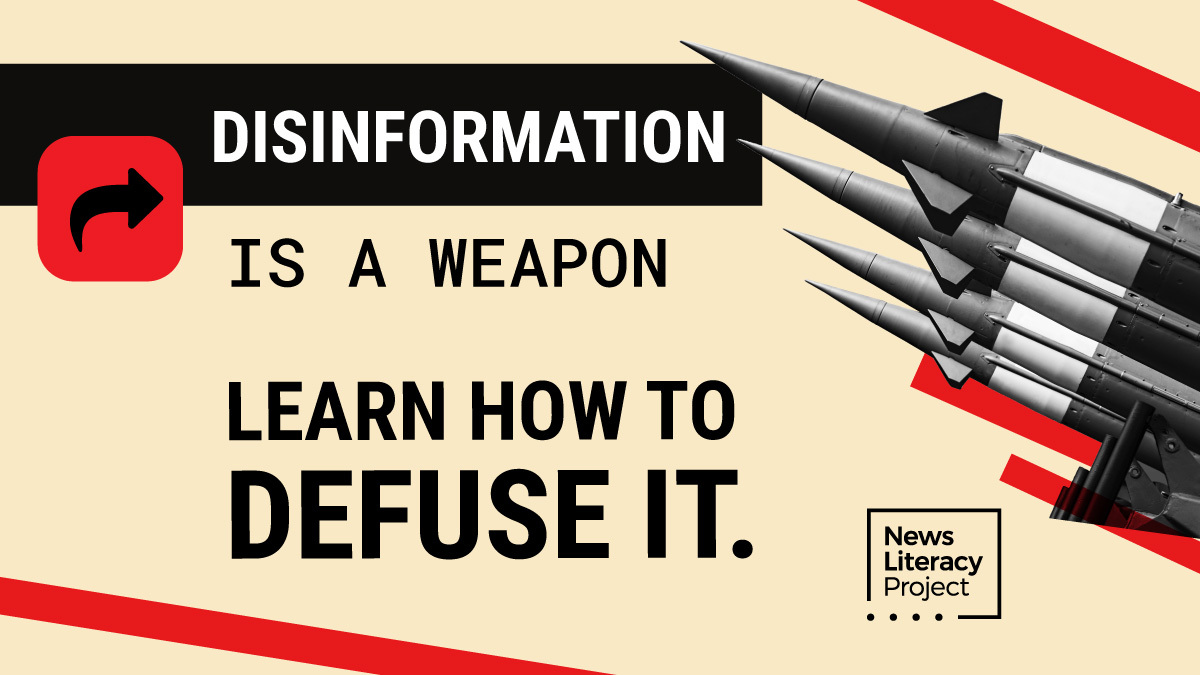Combating disinformation about the war in Ukraine
News-literate practices to help you avoid falling for Ukraine misinformation
As the situation surrounding the Russian invasion of Ukraine continues to unfold, it’s important for everyone to practice news-literate information habits. Understanding where to find credible information about the events in Ukraine and how to avoid being duped into sharing false and misleading information is vital. Here are three tips to help you keep your footing and avoid unintentionally spreading confusion and harm:
Check out more resources in our Flipboard magazine.
- Be cautious and discerning with what you believe and share.
- Out-of-context photos and video proliferate during military conflicts and other major news events. Avoid liking and sharing any visuals that haven’t been verified by credible, standards-based sources.
- Keep in mind: What you endorse and amplify online affects the perceptions of others. Slow down and follow common-sense steps — like these — before you react to information from unfamiliar sources.
- Familiarize yourself with Russian disinformation outlets, tactics and narratives.
- Russia has built an extensive foundation of disinformation to try to justify its military actions. Once established, these false narratives can be difficult to dislodge or trace back to their source.
- Keep in mind: Russian state-run propaganda outlets have an established presence on major social media platforms and can be hard to identify. A quick web search for the name of any unfamiliar news sources or unsubstantiated claims is your best first step to avoid misinformation.
- Put yourself in the way of credible information.
- For all the mis- and disinformation that circulates on social media, these platforms can also be powerful tools for accessing and curating timely, credible information. Be intentional about following professional journalists on the ground, reputable news organizations and fact-checkers debunking falsehoods in real-time.
- Keep in mind: Breaking news events create chaotic, fast-moving and challenging information environments. Resist the urge to demonstrate your concern by reflexively sharing sensational but unconfirmed posts and updates. Also remember that it's important to consider fairness and framing — as well as accuracy — as you follow news on Ukraine in the days ahead. Some have criticized recent news coverage, for instance, for including racist and Eurocentric sentiments that reveal a troubling double standard in coverage of this conflict compared to those outside of Europe.
- Related:
- “‘I’ll Stand on the Side of Russia’: Pro-Putin Sentiment Spreads Online” (Davey Alba and Stuart A. Thompson, The New York Times).
- “Scammy Instagram ‘war pages’ are capitalizing on Ukraine conflict” (Taylor Lorenz, Input).
- “War in Ukraine sparks new wave of misinformation” (Kat Tenbarge and Ben Collins, NBC News).

Russia has a history of using disinformation to “justify” actions condemned by the international community. However, its recent efforts to fabricate a rationale for invading Ukraine were quickly debunked by open-source investigators. They used geolocation to disprove a claim about supposed Ukrainian saboteurs sneaking into Russia; heat-sensing satellite data to disprove Russian claims of an attack; and video analysis tools to show that footage of a purported act of sabotage included audio of explosions taken from a different video.
- Related:
- “War via TikTok: Russia’s new tool for propaganda machine” (David Klepper, The Associated Press).
- “Geolocating TikTok videos of Russian military vehicles near Ukraine” (Derek Bowler, Medium).
- “How to spot video and photo fakes as Russia invades Ukraine” (Al Tompkins, Poynter).
Mounting criticism of Western news coverage of the war in Ukraine raises important questions about the influence of bias in news decisions during major developing stories. Some have criticized certain reporting on Ukraine as racist and called attention to story framing and word choices that portray “the invasion as the sort of thing that happens in poor countries, but not in Europe.” Even just the sheer amount of coverage, critics say, reveals a double standard in how Western media has covered this war compared to conflicts in other parts of the world.
- Related: “Opinion: What the shocking images of Ukraine’s dead say about the media — and our biases” (Eugene Robinson, The Washington Post).
- Idea: Read this statement from the Arab and Middle Eastern Journalists Association, which highlights news coverage examples involving Ukraine that have sparked widespread criticism. What stands out to you in these examples? How can word choice impact fairness and accuracy? How might your own biases affect the way you perceive news coverage of the war in Ukraine? How can perceptions of this coverage vary in countries around the world?
- Resource: “Understanding Bias” (Checkology virtual classroom).
A longstanding Russian disinformation narrative alleging that the United States is financing bioweapons labs has resurfaced during the war in Ukraine and taken hold among conspiracy theory communities, including QAnon adherents. The Russian government has for years tried to legitimize a variety of baseless assertions that the U.S. is developing biological weapons, including at labs in Ukraine. In reality, the labs were partly established to secure Soviet-era weapons, while also working to ensure that “dangerous pathogens do not fall into the wrong hands.”
- Related:
- “Fact check: False claim of US biolabs in Ukraine tied to Russian disinformation campaign” (Ella Lee, USA Today).
- “China amplifies unsupported Russian claim of Ukraine biolabs” (David Rising, The Associated Press).
- “YouTube is making money off a false Ukraine-biolabs conspiracy theory that is tied to Russian disinformation and QAnon” (Alex Kaplan, Media Matters for America).
The Russian Parliament passed a new law that criminalizes publishing information on the military that the Kremlin deems “false,” including reporting from independent news organizations and social media posts by individuals. In response to the law, one independent newspaper that has long been critical of the Russian government, Novaya Gazeta, announced on Twitter that it was deleting its war coverage to avoid prosecution. Other major news organizations, including the BBC, CNN, ABC, CBS and Bloomberg, responded to the law by suspending their broadcasts or reporting from Russia. The Washington Post announced that it would remove bylines and datelines from some stories to protect its journalists based in Russia.
- Discuss: Why do authoritarian regimes try to control information? Why might the Russian government want to control the way its invasion of Ukraine is described? What impact will this new law have on the quality of information about the war that Russians can access? What impact could this law have on people in Russia? How could this law impact the global community?
- Related
- “How Russia’s Nobel-Winning Newspaper Is Covering Ukraine” (David Remnick, The New Yorker).
- “TikTok suspends new content, livestreaming on platform in Russia” (Kalhan Rosenblatt, NBC News).
- “Activists are using ads to sneak real news to Russians about Ukraine” (Chris Stokel-Walker, MIT Technology Review).
- Resource: “Press Freedoms Around the World” (NLP’s Checkology virtual classroom).
Since Russia invaded Ukraine on February 24, the war has created an overwhelmingly chaotic information environment, one that even the savviest and most dedicated misinformation experts sometimes struggle to navigate. Credible information can get lost amid bogus posts on many social media feeds, creating a jumble of contradiction and confusion. Authentic photos of horrific civilian casualties, and of bombed apartment buildings, schools and hospitals, are interspersed with out-of-context footage from previous military actions, movies and video games. Posts celebrating Ukrainian bravery, patriotism and odds-defying counterattacks are likewise mixed in with out-of-context visuals and fabricated stories. It’s a dizzying combination of accurate information, tactical disinformation, trolling, engagement bait and even misinformation meant to inspire those who support Ukraine.
Here are three tips to help you stay focused on facts as the invasion of Ukraine stretches into its second month.
- Be mindful of Russian disinformation tactics. While we usually can’t know for certain if a post or comment online is from a Russian agent or a paid troll, we can learn to spot common Russian disinformation tactics and narratives. We should also recognize the complexities introduced by new propaganda tactics, such as the fabrication and disingenuous “debunking” of pro-Ukrainian “fakes” by the Russians — a scheme to cast doubt on authentic posts and weaponize the ethos of fact-checking.
- Don’t fall for conspiracy theory narratives. Conspiracy theory communities often adapt their beliefs to fit new developments in the world, and the war in Ukraine is no exception. In this case, however, conspiracy believers are also falling victim to Russian disinformation narratives, such as the baseless claim that the United States is supporting the development of bioweapons in Ukraine or the absurd notion that the conflict is being staged by actors. (The parallels here to COVID-19 conspiracy movements, such as the #FilmYourHospital effort, are unmistakable.)
- Sharing misinformation in “support” of Ukraine helps the Russian propaganda effort. While it may be tempting to like and share social media posts showing supposed Ukrainian victories, inspiring vignettes and other hopeful messages, the prevalence of falsehoods regarding the conflict fuels Russian and conspiratorial claims that the war is being exaggerated or faked in some way. Moments like these are a good time to pull back from social media posts by unknown individuals — and other forms of user-generated content — and wait for verification before you share.
As the world continues to watch the Russian invasion of Ukraine unfold — in many cases, on social media — it’s vital that we don’t add to the fog of confusion created by misinformation to obscure the atrocities being committed on the ground. We all have a responsibility to join the fight against falsehoods by learning to recognize them, report them to platform moderators and warn others away from them.
Related:
- “TikTok algorithm directs users to fake news about Ukraine war, study says” (Alex Hern, The Guardian).
- “Russia Still Using Twitter, Facebook To Push Conspiracy About Ukraine Hospital Bombing” (Abram Brown, Forbes).
- “Why Ukraine war misinformation is so hard to police” (Clare Duffy and Rachel Metz, CNN).




NLP resources
NLP staff provide context, guidance
- Experts available to discuss how to detect disinformation in Russia’s war against Ukraine
- NLP’s John Silva speaks with the AP about how to avoid spreading misinformation around Russia’s invasion of Ukraine
- Propaganda, fake videos of Ukraine invasion bombard users
- John Silva and NewsNation on how to spot misinformation about Ukraine and Russia
- John Silva joins CapRadio to talk misinformation amid Russian invasion of Ukraine
Credible sources of information about the war
- AFP Fact Check
- War in Ukraine, BBC News
- First Draft (Twitter thread)
- News from Ukraine, Eastern Europe, The Kyiv Independent
- Russia-Ukraine Disinformation Tracking Center, NewsGuard
- United Nations Human Rights Office of the High Commissioner
- Latest Ukraine Updates, United States Department of State




